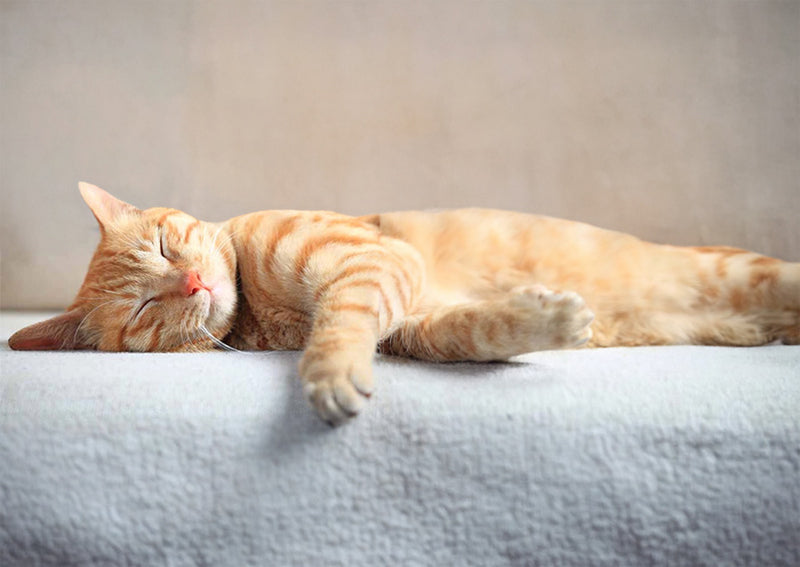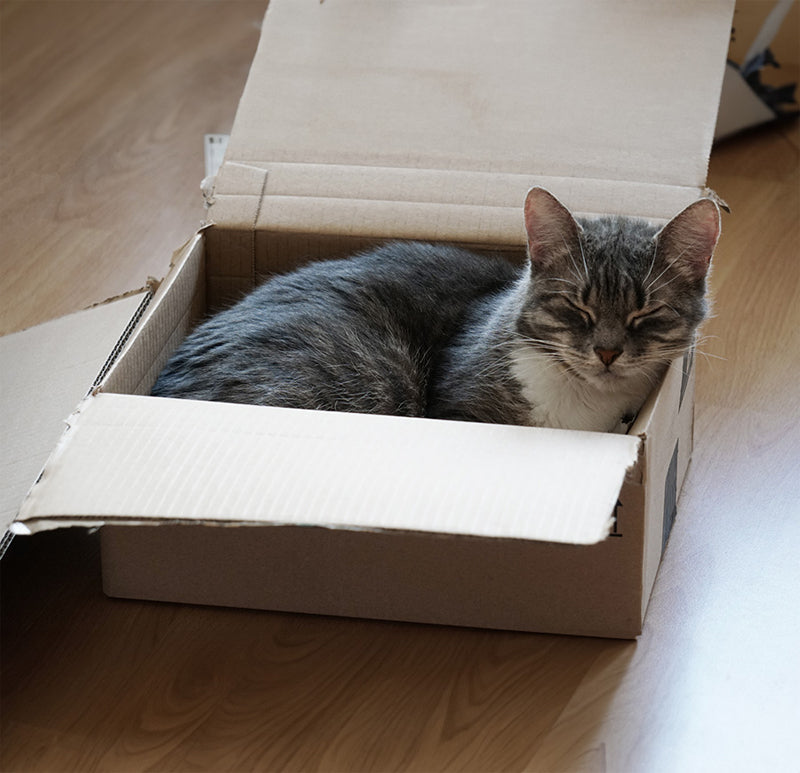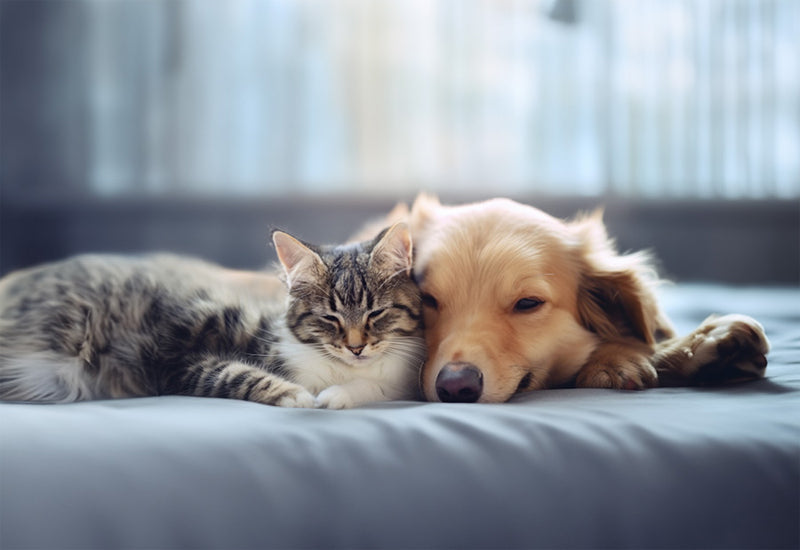No Products in the Cart
Ashima Yadav, a psychology student at Christ University, India, seamlessly combines academic pursuits with freelance content writing. Read more
Last Updated October 13, 2025
Cats have perfected the art of relaxation and seem to practice it about 16 hours a day, sometimes even more. With felines, as mischievous as they can be, there is nothing more adorable and entertaining than seeing them sleep, sometimes in a cute curled-up sleeping position, while other times in an empty vase. Cats sleep for a substantial portion of their life, and the way they sleep can tell us a lot about their personality and health. In this article, we look at common cat sleeping positions and their meaning, along with tips for understanding their sleeping postures.
Key Takeaways:
Observing cats' sleeping positions and patterns can provide valuable health insights, much like how human sleep positions and patterns offer clues about our well-being. Before we get into exploring common sleep positions and their meaning, it's important to know the difference between a resting cat and a sleeping cat.

When a cat rests, they are stationary and inactive. However, that doesn't mean they are sleeping. A resting cat could be sitting upright or lying down; however, these positions don't reveal anything about the underlying emotional state or well-being.
However, when a cat sleeps, their eyes are closed, and their muscles are completely relaxed, with occasional limb twitching, which is indicative of REM sleep. A cat's sleeping position can be indicative of their mental and overall well-being. For instance, a tightly curled sleeping position could indicate a cat seeking warmth and security, while if they are stretched out on the floor belly down, they might be trying to cool down.
Now that we know the importance of cat sleeping positions, let's take a look at some common sleep positions and what they mean.
While there are many different sleeping positions you could find your cat in, it's nearly impossible to cover all the cat positions. In this section, we will look at 12 of the most common sleeping positions adopted by cats.

This is one of the most comfortable sleeping positions that cats love to snooze in. In this position, their head is flat against the floor, and they sleep curled up with their tail wrapped around their body. This position keeps their vital organs all tucked in and helps them conserve body heat.

A cat curls up in this position in the wild to keep themselves safe. Interestingly, humans exhibit a similar behavior when they sleep in the fetal position, curling up on their side with legs drawn close to the torso.
If your cat sleeps in this position, they most likely just want some warmth and protection. However, it could also just be a really comfortable position that they love.
In this position, your cat sleeps on their back with their belly exposed and paws in the air. This is one of the most adorable cat sleeping positions. When a cat sleeps belly up, all their vital organs are exposed, which shows the immense trust that your feline friend has in you. Moreover, the cat is very relaxed and confident when choosing this position for their naptime.

This position might be very tempting to pat your cat's stomach. However, it would be best if you avoided it because it can affect the trust that your fur friend has in you.
This is another vulnerable position wherein the cat lies on their side with their belly half exposed and front and back legs stretched out in front of them. Cat's vital organs are also exposed in this pose, which depicts the trust your fur kid has in you.

It also means that the cat is comfortable in the home surroundings and feels safe enough to nap with its belly exposed. However, since it is a vulnerable position, it's more of a catnap position than a deep sleep position.
If you have ever seen your cat sleep with paws warping in all directions and head twisted at a weird angle, well, your cat sleeps in an acrobat or contortionist position. This might seem like a very uncomfortable cat sleeping position to you.

However, cats are highly flexible creatures with elastic spinal columns and loosely attached shoulder blades, allowing them to twist and sleep in weird positions while being comfortable. If you're wondering what this position means, well, scientists and doctors are wondering the same!

If your furry friend is sleeping with paws covering their face or over the eyes, it's their version of 'do not disturb'. Cats usually sleep in this position to block out the light or give off the sign that they don't want to be disturbed. It's one of the cutest sleeping positions among cats.

Many cats love sleeping under the covers, with their nose poking out for air. Cats prefer this position because it keeps them warm by helping them preserve their body heat. Moreover, they might enjoy the familiarity and comfort of your scent on the covers. Sleeping under covers or blankets also helps them feel safe. However, always be sure where your cat is sleeping to avoid lying on them.
More often than not, cats love to squeeze into boxes that are too small for them. This behavior originates from their natural instincts; wild cats need to hide from their enemies. Being in enclosed spaces makes them feel safe because they're supposedly hidden from their enemies while they can see around them.

Sleeping in a box gives them that feeling of safety and allows them to be more relaxed and fall into deep sleep. Domestic or indoor cats might also sleep in a box if you have a new pet or to hide from someone who is constantly trying to pet them.
In the loaf position, a cat sleeps with its front paws curled underneath and its head upright, resembling a loaf of bread. This cat sleeping position is fairly common among cats as it ensures that their vital organ are safe and that heat is preserved. Moreover, it also offers them the ability to spring into action if required.

A cat likes to relax in this position when it feels the need to be alert while resting. Though they might seem like they are in deep sleep, this is just a naptime position. A cat naps in a position where they can be alert while relaxing.

This cat sleeping position seems like the cat is trying to mimic humans by sitting straight. However, it's a nice sleep position for them. Cats sleep with their vital organs exposed in this position, demonstrating their trust and confidence in their surroundings. Moreover, this position gives them easy access to grooming their bellies while taking naps in between. Adult cats might also prefer this position because it provides back support to their muscles.
What's a better sight for cat lovers than seeing their cat sleeping with their tongue out (more commonly known as the blep)? A cat sleeping like that simply means it is relaxed enough that its jaw is loose and its tongue slips out.

While it's a very cute and normal position, do pay attention if your cat suddenly starts sleeping in this position and is drooling or bleeding. If so, please consult your vet, as it can be indicative of dental issues.
Cats tend to sleep with their eyes fully open or partially open. This comes from a cat's natural instinct to be alert to both predators and enemies around them. A cat napping in this position remains aware of its surroundings and is ready to spring into action in case of any threats.

Though it's normal for cats to sleep with eyes open or half open, observe for any signs of eye swelling or discharge, and if you notice anything, it's best to consult your vet.

Sleeping perched up on tall furniture like a shelf, dining table, or refrigerator serves two purposes. One, it gives them a good vantage of the entire area, which helps them keep an eye out for prey. Two, it saves them from potential threats. If domestic cats are sleeping perched up on top of some furniture, they are trying to feel safe and in control of the situation.
Cats have an infamous reputation for being enigmatic and, at times, seemingly heartless. However, most cats love sleeping with their pet parents or furry friends. Trust us on this: cats are not as heartless as they are made out to be, because the affectionate cat sleeping positions that we will look at in this section will bring out a softer side of your kitty. Most of these positions are a sign of trust and companionship.

A cat sleeping on you is a top-tier thing to flex about. Enjoy the moment if your cat chooses to sleep on you, be it on your stomach, head, or chest. Cats like to sleep on their humans for various reasons, the first and most obvious being that they like being close to you. Sleeping on you can also provide them warmth and comfort.

If a cat is sleeping on your chest, the sound of your heartbeat might be a source of comfort for your kitty. While they are sleeping on your head, they might be just looking for a soft place to sleep close to you, and the fact that your head moves less than the rest of your body while sleeping also offers them fewer disturbances.

If a cat is sleeping at your feet, it's giving you warmth as well as getting warmth from you. Being close to your feet also allows them to keep you safe and alert you in case of any threats. Similarly, sleeping between your feet also provides them with a sense of safety and warmth. Cats also take up these positions to mark 'their territory.'
Some cats prefer sleeping next to you rather than on top of you. This position also shows that they are bonded with you. In this position, most cats sleep with their back to you so that they can watch the environment for any threats. This shows that they trust you.

Moreover, sometimes, your cat might sleep next to you but with a buffer of space – not so close to you, yet not so far. Well, it's just that some kitties like to enjoy their personal space while also enjoying their human's company.

Cats and Dogs getting along in households is not unheard of. If your pets are introduced properly and given enough time to get comfortable, they can quickly start trusting each other. If your cat has gotten accustomed to sleeping with your dog, you have most likely done a great job at co-parenting them. It means that they have formed a bond and seek companionship while they rest.

If you have more than one cat, chances are your cats sleep together from time to time. If you find your cats sleeping together, it means they trust each other and have formed a bond. They might also do it just for the sake of comfort.
In the subtle language of cat sleeping positions, certain postures can serve as distress signals, offering crucial insights into the feline's physical well-being. If your cat suddenly starts sleeping very still or favors sleeping on one side, it could be a sign of some underlying issue.

These subtle changes in your cat's sleeping habits speak volumes about potential pain or discomfort, whether it's a hunched posture, avoiding usual sleeping spots, or a reluctance to stretch out. In this section, we look at some of the general cat sleeping habits or common positions that cats assume when sick or in pain.

Similar to humans, a sick cat might be tense and exhibit a hunched body posture with its head tilted down. Moreover, their ears would be rolled out, their whiskers straight, and their coat would look dull and matted. If you see your cat constantly sleeping in this position, consider taking it to the vet.
Your cat might be sleeping next to the water bowl simply because it's a comfortable spot in the house. However, if your cat is sleeping close to the water bowl due to dehydration, you need to pay attention to other symptoms. First, gently pinch the skin between its shoulders to check if your cat is dehydrated. If the skin doesn't immediately return to its normal state after the release, it may be dehydrated.

Paired with other symptoms, it could be a sign of diabetes or Kidney disease. Look out for symptoms of lethargy, inability to jump, and a change in gait, for diabetes and bloody urine, weight loss, and bad breath for kidney diseases.
Your cat sleeping in the litter box is definitely something to be worried about. They could have underlying conditions like urinary or digestive issues, such as diarrhea, constipation, UTI, etc. However, adult cats might be sleeping close to the litter box for easy access if they have arthritis. In these senior cats, it could also be a sign of dementia or cognitive dysfunction.

So, if your cat has suddenly started sleeping in the litter box, it's time to consult your vet as soon as possible.

A cat might sleep with their face down and eyes covered with their paws simply to block light, keep their nose warm, or if it wants to be left alone. They may also be exhausted from a long day of their antics. However, this position can also indicate that your cat may be sick. If your cat sleeps in this position, observe for any other symptoms like lethargy, weakness, decreased appetite, etc.

Cats love to sleep in hard-to-reach places and their personal space. However, if your kitty is sleeping in unusual hidden places more often than not, monitor their other behaviors like eating habits, defecation, and energy levels. If any changes in habits are observed, it is recommended to consult your vet.
A cat's sleeping position can tell us much about their physical and mental well-being. For instance, a cat sleeping in a belly-up position means that it feels safe and comfortable in its surroundings, while a cat sleeping in a curled-up position means that it is trying to protect its vital organs and is seeking warmth.
Cats usually sleep in weird positions because they're relaxed and comfortable. Their flexibility allows them to twist in seemingly uncomfortable positions. However, if your cat is sleeping in hunched-down or face-down positions, it might be unwell.
Belly-up is known to be a happy sleeping position among cats. So, if you see your cat's belly on display, it's a sign that they are happy, feeling safe, and comfortable.
Pillows can complement a cat’s sleeping position, especially if they’re fond of occasionally going into the Face Plant posture, where they sleep with their faces planted down into a pillow or blanket. An eco-friendly pillow, like a latex pillow, wool pillow, or buckwheat pillow, is ideal if your cat loves sleeping on a pillow. They don’t off-gas chemicals like synthetic pillows and give your furry friend a clean, cozy company.
Related blog posts:
3. What does your sleep position say about your personality?
5. 4 Postures to Help You Sleep Better
Disclaimer: What is said in this article has been referenced from multiple sources and is intended only for educational and informational purposes. Please note that no content in this article is a substitute for professional advice from a qualified doctor or healthcare provider. Always consult an experienced doctor with any concerns you may have regarding a health condition or treatment, and never disregard any medical suggestions or delay in seeking treatment because of something you read here.
Notify me when available
We will send you a notification as soon as this product is available again.
We don't share your email with anybody


